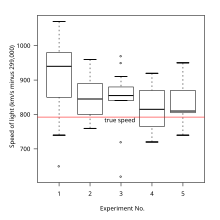Summary statistics

Indescriptive statistics,summary statisticsare used to summarize a set ofobservations,in order to communicate the largest amount of information as simply as possible. Statisticians commonly try to describe the observations in
- a measure of location, orcentral tendency,such as thearithmetic mean
- a measure ofstatistical dispersionlike thestandard mean absolute deviation
- a measure of the shape of the distribution likeskewnessorkurtosis
- if more than one variable is measured, a measure ofstatistical dependencesuch as acorrelation coefficient
A common collection oforder statisticsused as summary statistics are thefive-number summary,sometimes extended to aseven-number summary,and the associatedbox plot.
Entries in ananalysis of variancetable can also be regarded as summary statistics.[1]: 378
Examples[edit]
Location[edit]
Common measures of location, orcentral tendency,are thearithmetic mean,median,mode,andinterquartile mean.[2][3]
Spread[edit]
Common measures ofstatistical dispersionare thestandard deviation,variance,range,interquartile range,absolute deviation,mean absolute differenceand thedistance standard deviation.Measures that assess spread in comparison to the typical size of data values include thecoefficient of variation.
TheGini coefficientwas originally developed to measure income inequality and is equivalent to one of theL-moments.
A simple summary of a dataset is sometimes given by quoting particularorder statisticsas approximations to selectedpercentilesof a distribution.
Shape[edit]
Common measures of the shape of a distribution areskewnessorkurtosis,while alternatives can be based onL-moments.A different measure is thedistance skewness,for which a value of zero implies central symmetry.
Dependence[edit]
The common measure of dependence between paired random variables is thePearson product-moment correlation coefficient,while a common alternative summary statistic isSpearman's rank correlation coefficient.A value of zero for thedistance correlationimplies independence.
Human perception of summary statistics[edit]
Humans efficiently use summary statistics to quickly perceive the gist of auditory and visual information.[4][5][6]
See also[edit]
- Common test statistics
- Descriptive statistics
- Sample statistics
- Sufficient statistic
- Data processing
References[edit]
- ^Upton, Graham; Cook, Ian (2 October 2008)."Dictionary (S)".A Dictionary of Statistics(Second (revised) ed.).Oxford University Press.ISBN978-0199541454.LCCN2008300706.OCLC935100347.OL23145891M– viaInternet Archive.p. 378:
summary statistics [...] *ANOVA table might be referred to as summary statistics
- ^Bullen, P. S. (31 August 2003).Handbook of Means and Their Inequalities.Mathematics and Its Applications. Vol. 560 (2 ed.).Springer Dordrecht.doi:10.1007/978-94-017-0399-4.ISBN978-1-4020-1522-9.LCCN2003060794.OCLC939214285.OL8370727M.
- ^Grabisch, Michel; Marichal, Jean-Luc; Mesiar, Radko; Pap, Endre (2009).Aggregation Functions.Oxford University Press.ISBN978-0521519267.
- ^Piazza, Elise A.; Sweeny, Timothy D.; Wessel, David; Silver, Michael A.; Whitney, David (2013)."Humans Use Summary Statistics to Perceive Auditory Sequences".Psychological Science.24(8): 1389–1397.doi:10.1177/0956797612473759.PMC4381997.PMID23761928.
- ^Alexander, R. G.; Schmidt, J.; Zelinsky, G. Z. (2014)."Are summary statistics enough? Evidence for the importance of shape in guiding visual search".Visual Cognition.22(3–4): 595–609.doi:10.1080/13506285.2014.890989.PMC4500174.PMID26180505.
- ^Utochkin, Igor S. (2015)."Ensemble summary statistics as a basis for rapid visual categorization".Journal of Vision.15(4): 8.doi:10.1167/15.4.8.PMID26317396.
External links[edit]
 Media related toSummary statisticsat Wikimedia Commons
Media related toSummary statisticsat Wikimedia Commons
